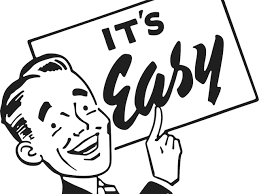Contents
The Basics – Why Card Counting Is Easy
Imagine what would happen if we took all the small cards out of the deck and just played blackjack with broadway cards (ten through ace). That would be a fun game! We’re paid 3:2 whenever we get blackjack (21) but the dealer just gets 1:1 when he gets to 21. We would make a lot of money in this game. 🙂 That’s the idea behind card counting – identify times when the shoe is loaded with big cards. It isn’t a matter of memorizing all the cards in the deck, we’re just finding those opportunities when the percentage of high cards left to be dealt out is high.
There is a misconception that card counters are geniuses with amazing memories. People tend to think that they memorize every single card and that isn’t how it works. Card counters use various systems where groups of cards are treated the same way such that it is easy to keep track of things.

The Hi Lo System
We use the hi lo system:
2, 3, 4, 5, 6: +1
7, 8, 9: 0
T, J, Q, K, A: -1
What does this mean? Suppose the first card out of the shoe is the 3 of clubs. This is a good thing for the players. It means that a small card is gone so we’re left with bigger cards. As such, the running count which started at 0 is now +1. The higher this running count gets the better.
Some books recommend the hi opt system. It is just like the above hi lo system except that it is simpler because A and 2 are not counted so they are 0 instead of -1 and +1 respectively. We prefer hi lo because it is a more accurate representation of the player’s advantage even though it is a little more work.
Examples
HAND 1
It is the first hand of the shoe and Paul is playing the dealer one on one. Here is how the hand ends:
Paul:
Card / Count
J of clubs / -1
5 of diamonds / +1
4 of hearts / +1
Dealer:
Card / Count
7 of spades / 0
9 of diamonds / 0
3 of clubs / +1
What is the running count at the end of this first hand? It is -1 +1 +1 +0 +0 +1 or +2.
HAND 2
It is the second hand of the shoe and Paul is playing the dealer one on one. After the first hand, we know the count is +2.
Here is how the hand ends:
Paul:
Card / Count
7 of hearts / 0
8 of spades / 0
2 of clubs / +1
Dealer:
Card / Count
8 of spades / 0
5 of spades +1
4 of hearts +1
What is the running count at the end of this second hand? We add the previous total of +2 to the total of this hand so we get +2 +0 +0 +1 +0 +1 +1 or +5.
Running Count vs True Count
The running count gives us the raw total for the shoe. This total is weighted based on the number of decks left to be dealt. At the beginning of the deck this running count does not carry much weight. Towards the end of the shoe when there are fewer cards left, this running count has more weight.
The true count is the running count divided by the number of decks left in the shoe. For example, if the running count is +6 and we have 2 decks left in the shoe then the true count is +3. If the running count is -2 and we have 2 decks left then the true count is -1. The true count is what matters for betting but we can’t know the true count unless we also know the running count.
Betting
The true count dictates the amount that we bet. We define a betting unit as the minimum bet at the table. Once the count is above zero then our bet is the same number of units as the true count +1.
Here it is on a $10 minimum table:
Count 0 or Less: bet $10
Count +1: bet $20
Count +2: bet $30
FAQ
Q: I’m a bit confused on the running count and true count. I assume the true count is more accurate?
A: Think of the running count as just a raw number and the true count as more of an indicator about the percentage of our advantage or disadvantage. It is the true count that determines our betting strategy but we need to know the running count in order to calculate the true count.
Q: Is there an easy way to determine how many decks have been gone through for the true count – do you just try to keep track of how many cards have been dealt?
A: There are many ways to keep track of the number of decks left to be dealt. The first thing is to identify how many decks are in the shoe. Some shoes use 6 decks. Once we know the number of decks at the start then we can do several things:
1. See how full the shoe looks. If we started with 6 decks and it is about half way as full as it was at the start then we have about 3 decks left.
2. Look at the number of cards/decks in the discard pile. If it has about 2 decks worth of cards and we started with 6 decks then we have about 4 decks left.
3. Keep track of the number of hands that have been dealt in the shoe.
Q: How much more valuable is it to keep track of true count vs running count?
A: A player can’t know the true count without first keeping track of the running count. This is because the true count is the running count divided by the number of decks left to be dealt out. When there are a large number of decks left then the running count can be less meaningful. For example, when there are around 6 decks and we have a running count of +1 then we have a true count of just +1/6 which might as well be 0. However, when we’re playing single deck then a running count of +1 is also a true count of +1 which is a nice edge.
Q: What about hi lo vs hi opt?
A: Like we said, these systems are the same except hi lo keeps track of aces and deuces. We believe that keeping track of aces and deuces is worth the effort. In other words, we think players will have better results with the hi lo system than the hi opt system. Having said that, accuracy is important. If a player makes a lot of mistakes counting aces and deuces then maybe it is best for him to use the hi opt system and treat them as 0 instead of making errors.
Q: How do you do the actual counting in your head? On a card by card basis? I’m just wondering what is the fastest way. In other words, do you look at each card as it comes out and decide to subtract 1 or add 1? Or do you group the cards by counting all the +1s, then subtracting at the -1s?
A: Sometimes counters look at things on a card by card basis as they come out. Sometimes they group them together. Grouping can make the process a lot easier when high cards and low cards cancel each other out.
Online Casinos with Live Dealer Blackjack Tables
You can actually practice and utilize your blackjack card counting skills while playing online, you just have to play at a casino that offers live blackjack dealers. And thankfully, many of the top online casinos offer live dealer games including multiple blackjack tables. Below is a list of the live dealer blackjack casinos we recommend. Have fun winning lots of money.
| Casino | Live Blackjack Games | Casino Bonus |
|---|---|---|
| Bovada Casino | Standard Blackjack and Blackjack Early Payout, 28 Tables Available, Table Limits $5 - $250. | 125% Deposit Bonus up to $1250 |
| Slots.LV Casino | Standard Blackjack and Blackjack Early Payout, 28 Tables Available, Table Limits $5 - $250. | 200% Deposit Bonus up to $1,000 |
| Drake Casino | Live Tables from Latin America, Europe, and Eastern Europe, Table Limits $10-$100, 7 Tables Available. | 60 Free Spins No Deposit Bonus, 300% Deposit Bonus up to $2,000 |
| Ignition Casino | Standard Blackjack and Blackjack Early Payout, 28 Tables Available, Table Limits $5 - $250. | 150% Casino Bonus up to $1,500 and 150% Poker Bonus up to $1,500 for Total of $3,000 |
Blackjack card counting is not that difficult, anyone can do it, it just takes practice!
Have You Tried Card Counting? Leave Feedback Below!
Submit your review | |

